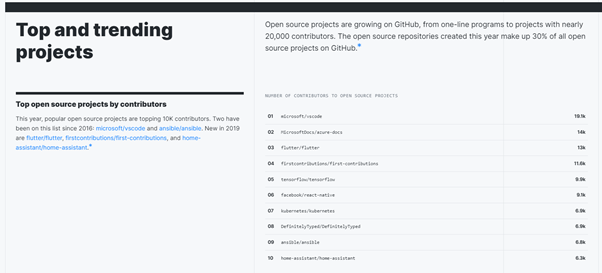InnerSource model of High Performing Organizations
Have you ever wondered how OpenSource projects like microsoft/vscode can quickly get more than 10000 collaborators around the world effectively? Below is a screen snap from the State of Octoverse Report 2020

The concept of InnerSource is not new. Tim O’Reilly coined this term long back in the year 2000. After the success of github.com, the cultural patterns of open source have got the researchers’ attention to see if they can be adapted within the organizations. If you are looking for a successful model for collaborating within a distributed DevOps enterprise, consider implementing InnerSource.
InnerSource is an adaptation of OpenSource practices to code that remains proprietary and can be seen only within a single organization or a small set of collaborating organizations.
OpenSource Projects
OpenSource contributors and maintainers are running projects of all sizes. Developers are looking to understand the latest software tools, techniques, and best practices. These OpenSource projects’ success is driven by its vision, solving real-world problems of its users’ needs at speed and reliability.
The Apache Way
The Apache software foundation, consensus-driven, an open development process, was refined over the past 20 years. Some of the revolutionary projects like Apache, Kafka, Tomcat have been developed and maintained by the global community.
The Apache Way defines the principles of its success:
- Earned Authority
- Community of Peers
- Open Communications
- Consensus Driven Decision making
- Responsible Oversight
These principles define and refine the processes that are easy for the community to contribute than a rigid set of processes and practices without clarity.
How InnerSource differ from OpenSource
The critical difference is that Innersource is under the radar of an organization. The “openness” of the projects extends across many teams within the organization. As the technology, best practices, and patterns are revealed without fear; organizations benefit from the knowledge and creativity of the entire spectrum of resources working with it.
The scale at which the OpenSource project operates can teach us a few lessons—and help your business build better software faster using Innersource.
Benefits of adopting InnerSource for Organizations
InnerSource provides a vast advantage for scaling high performing teams.
It improves teams to get their feature request done of its dependent components without the long-term maintenance burden. It improves alignment with all its consumers. As the teams understand the components of other teams’ organization can cross-pollinate talents.
Breaking down the Silos
As teams contribute to the teams, it is dependent on it naturally cross-pollinate ideas and talents. Over time, teams break the traditional silos culture and improve the overall value delivery flow.
Spread the best-practices
As the teams’ codebase is visible and accessible, teams can learn the best practices and adapt much faster. Teams define and document the standards they expect from the contributors. For instance, Kubernetes Contribution Guide (Kubernetes Contributors Guide, n.d.) defines the value and setup for running Kubernetes, community meetups, and mentorship models.
InnerSource becomes a force multiplier
InnerSource model allows teams to temporarily act larger than their actual size during times of high demand. When the demand has ended, the team throughput scales back to normal levels, all without any micromanagement of team headcount or work items.
Good Reads
An Introduction to InnerSource
O’Reilly Report: Understanding the InnerSource Checklist
Microsoft Enterprise DevOps Report Getting Started with InnerSource – PayPal Case Study InnerSource Patterns